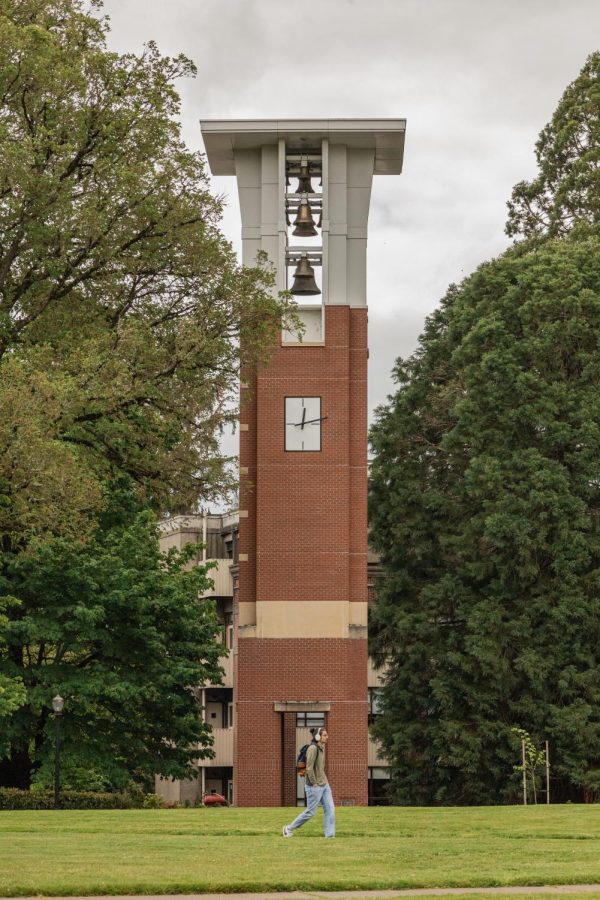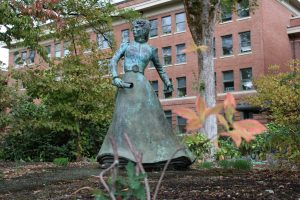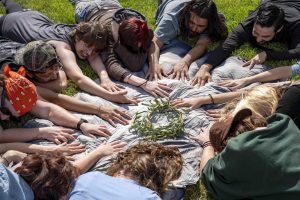Bells and whistles: Everything you didn’t know about the OSU Bell Tower
Director of University Events gives a detailed explanation of the bell tower’s inner mechanisms
Ashton Bisner, OMN Photographer
The OSU Bell Tower in front of the Valley Library on May 23. Multiple times throughout the week, the bell tower rings a special tune rather than just the common chimes.
June 21, 2023
Students and community members in the Corvallis area should all be familiar with the chimes that play every hour – they can be heard far and wide. The Oregon State University campanile, or bell tower, is a well-known landmark on campus, sitting between the Valley Library and Community Hall next to the library quad.
The bell tower was constructed and dedicated to H. Dean Papé, on Sept. 28, 2001. Inspiration for the bell tower came from Papé’s grandson, who was an engineering student at OSU at the time. It was designed to match the Valley Library. Papé graduated with a degree in mechanical engineering in 1942, when OSU was still known as Oregon State College. After graduating, Papé and his brother took over their father’s company, The Papé Group Inc. Papé remained active in the OSU community up until his passing in 1996. The Papé family contributed to many projects around campus, such as renovations to Reser Stadium and the construction of the Valley Library. He was an active participant on the OSU Foundation’s Board of Trustees and even served as the foundation’s president from 1983 to 1985. Papé also received the “Volunteer of the Year” award from OSU in 1985.
Angela Carlson, who retired in 2020 after teaching for 51 years, taught music theory and music appreciation, but also previously programmed songs into the bell tower. She made about 20 arrangements that are still played today.
“I only did about three or four sessions,” Carlson said, “I’m a senior citizen, so the tunes I know are more traditional ones. That’s what they asked me to do originally. I did things like the beaver fight song and more familiar tunes like ‘My Country ‘Tis of Thee’.”
Carlson said that programming it was like any other recording.
“You kinda wait,” Carlson said, “And then do your thing and you hope it’s good. Some of them I got in the first try, and others took me two or three times to get it right. They were short, at the most four measures of music; you don’t want a five minute song playing on the bells.”
Carlson said that at first, the bell tower chimed on the quarter-hour, tat the half-hour and at the top of the hour.
“The man who was teaching recording and editing at the time protested because the chimes interfered with some of their recording classes because it picked up the sound,” Carlson said. “And so they dialed it back to just on the hour.”
When the tower was originally installed, there were only four bells. The tower has been expanded twice, thanks to the generosity of Mrs. Papé, once in 2014, adding nine additional bells, and once again in 2018, adding another nine for a total of 23 bells.
The tower is currently missing two bells, a C-sharp and a D-sharp, to make a complete line-up; however, these can’t currently be installed because the tower would have to be made taller to accommodate the additional bells.
The bell tower is programmed in a nearby location on campus. The system is a Verdin Carillon Master, which sits in a dark and dusty basement, and there is a little two-octave keyboard that sits below the computer. Shelly Signs, the Director of University Events here at OSU, went in depth with exactly how the bell tower works.
“Like I said, it’s a computer,” Signs said, “We have the ability to manually play songs using this particular function.”
The keyboard is used to record songs for the bells to play. The system can be shut off from playing over the bells and can be used just to listen back on the keyboard to make sure everything is right, and that the tune is ready for public playing. The system also has a quick play function that can be used to play any song on the song list at any time. The system is not perfect, however, and there are some challenges with programming the tower.
“One thing that I find interesting,” Signs said, “is that the songs that are programmed into the system play very nicely, whereas the ones we program in ourselves, we pretty much stick to one chime at a time, otherwise the layering doesn’t come out as clear and as beautiful as we would like. What’s also interesting is the strike of the bell; so the bigger the bell, the longer it takes to hit the side of the bell. If you strike a high note, it hits really quickly. If you strike a low note, it takes a little bit longer for the clacker to actually hit, so that’s interesting on timing. Then the spacing of the notes, or the rhythm, is also a challenge, which is maybe why I have fewer students than I would anticipate being interested in programming music in.”
The system came prepared with a selection of many songs pre-programmed onto the machine. A lot of which are not used.
“We’re very selective,” Signs said. “It has a lot of … I’d say more old-fashioned songs, like ‘Take Me Out to the Ball Game.’”
They try to keep the songs to 20 seconds so that it doesn’t impede on any classroom work or people who are studying in the library. They do, however, have longer songs in the system that they occasionally play, such as “Hallelujah,” which they played when the performer Leonard Cohen passed away.
The current songs that the bell tower plays Monday through Friday are: 8 a.m. – “Que Sera,” noon – “Thaxted,” 6 p.m. – “Freres Jacques” and Sunday at 10 a.m. – When You Wish Upon A Star.
Signs used to try to change the line-up every term, but they’ve fallen away from that cycle since the pandemic. Everything that’s played has to be approved by a special ad hoc committee. This committee is mostly made up of building managers in the surrounding area as well as representatives from the foundation and the music department, who can all vote on and approve changes to the bell tower’s line-up. The Office of Institutional Diversity also works with Signs to make sure none of the potential selections could offend any students or community members.
Signs has expressed an interest in finding students and faculty that are interested in the bell towers, to program songs into the system themselves.
“However,” Signs said, “I do welcome individuals who are interested in having a role, or participating in the programming of (the bell) or submitting ideas. I welcome that feedback and engagement because I really think of this as our campus community tower. It’s really fun, and I think it would be neat to be able to say, you know, ‘I wrote that song,’ or ‘I played that song into the system.’”
Any students or faculty that are interested in programming the bell tower can reach out to Shelly Signs here: [email protected] / [email protected], Students and community members can also submit songs to be considered for playing at: https://oregonstate.qualtrics.com/jfe/form/SV_4GDbw03bAdC49G5






